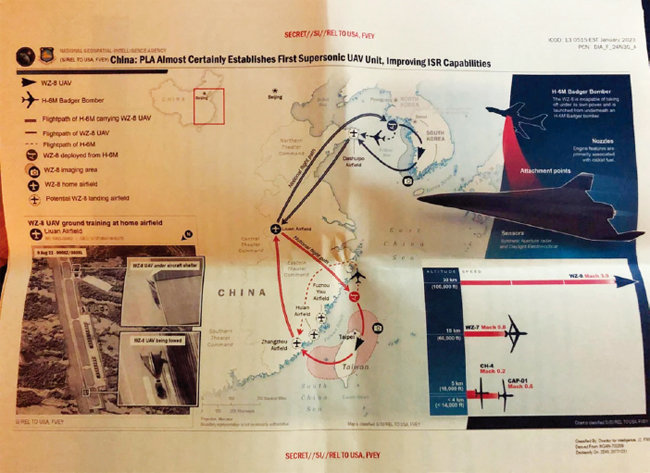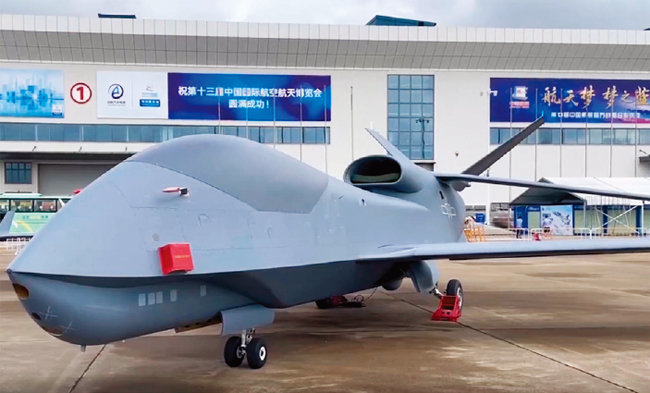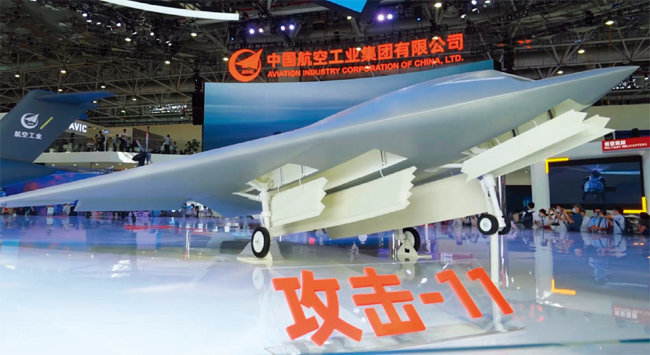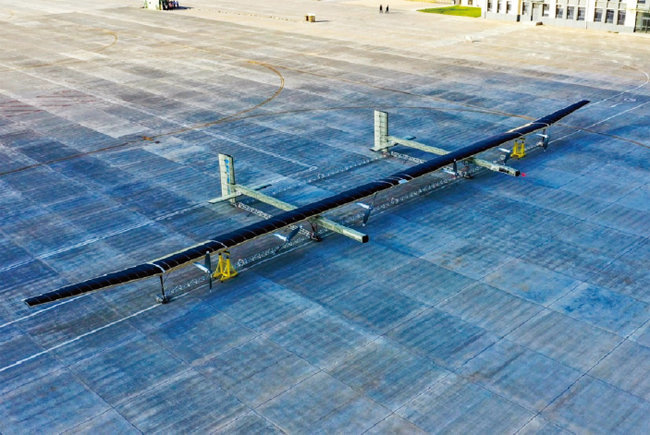The Wuzhen (無偵·WZ)-8 is the latest supersonic stealth unmanned aerial vehicle (drone) deployed by the People’s Liberation Army of China. It is a ‘secret weapon’ that is evaluated as the most powerful among drones possessed by the Chinese military. The identity of WZ-8 was revealed because of information from US intelligence agencies leaked to the online chat platform ‘Discord’ chat room by Jack Teixeira, an Air Force Private in the Massachusetts National Guard. The Washington Post (WP) of the United States said on April 18 that it had obtained a confidential document from the National Geographic Information Agency (NGA) among the information stolen by Private Teixeira, and returned after reconnoitering Korea and Taiwan with satellite photos of WZ-8 contained in this document. It also revealed the expected flight path.
The NGA believes that the WZ-8 may have conducted reconnaissance activities, such as photographing Taiwanese military bases as well as USFK bases such as the Pyeongtaek, Gunsan, and Osan bases in Gyeonggi and the West Sea of Korea. According to classified NGA documents, the strategic bomber H-6M, which took off from Luan Air Base in Anhui Province, China, flies to the east coast of China and launches the loaded WZ-8. It is said to fly at three times the speed of sound in km and conduct reconnaissance activities. Luan Air Base is located 560 km inland from Shanghai, China, and is managed by the PLA Eastern Front Air Force. According to the satellite picture dated August 9 last year, which NGA has, two WZ-8s are deployed on the runway of Luan Air Base.
The WZ-8 was first unveiled at a military parade commemorating the 70th anniversary of the founding of China in 2019, and was also exhibited at the Zhuhai Air Show held in Zhuhai, Guangdong Province in September 2021. The WZ-8 is an advanced model that integrates China’s drone technology, and can reconnaissance from the Pacific region to Guam, a military hub for the US military. It adopted a rocket propulsion method to fly at supersonic speed at high altitude, and is estimated to fly at Mach 4.5 at 40 km above the earth. In addition, it can guide various missiles, including the DF-26D anti-ship ballistic missile as well as the Dongfeng DF-17 missile. What is most worrisome is that it can provide real-time target information essential for attacking moving targets such as aircraft carriers. Since the DF-17 is a missile designed to mount a hypersonic glide vehicle (HGV), it can neutralize key military assets in South Korea and Japan, including US Navy aircraft carriers.
 The reconnaissance flight path of the Chinese military supersonic stealth drone WZ-8 as indicated in classified documents of the US National Geographic Intelligence Agency (NGA). Twitter
The reconnaissance flight path of the Chinese military supersonic stealth drone WZ-8 as indicated in classified documents of the US National Geographic Intelligence Agency (NGA). TwitterThe WZ-8 was developed by the Chengdu Aircraft Design Institute under the Aviation Industry Corporation of China (AVIC). It is 11.5m in length, 6.7m in wingspan, and 2.2m in height, and various reconnaissance equipment such as electro-optical sensors are loaded on the fuselage. In addition, it has a smooth appearance to reduce the radar reflection area and has a stealth function by using composite materials. The drone ascends at high speed and then glides to the retrieval point using altitude and speed similar to that of a ballistic missile. This drone is estimated to be the fastest in the world, except for the SR-72 Blackbird (Mach 6), an unmanned reconnaissance aircraft of the US defense company Lockheed Martin. “The main use of this drone is not Taiwan, but reconnaissance of US military bases in the Pacific Ocean,” said Chi Liping, director of air system research at the National Zhongshan Institute of Science and Technology, a national defense research institute in Taiwan. pointed out Din Chung, a senior researcher at the Potomac Policy Institute in the US, said, “The reason why China has deployed these drones is to increase its ability to monitor the entire Indo-Pacific region.” We have to be vigilant about power,” he stressed.
 Chinese military high-altitude long-range reconnaissance drone WZ-7 unveiled at the 2021 Zhuhai Air Show in China. CCTV
Chinese military high-altitude long-range reconnaissance drone WZ-7 unveiled at the 2021 Zhuhai Air Show in China. CCTVIn fact, the Chinese military is using drones to significantly expand reconnaissance activities not only in Taiwan, but also in Northeast Asia, including South Korea and Japan, and the South and East China Seas. In particular, in recent years, reconnaissance flights around Taiwan have become commonplace. According to Taiwan’s Ministry of National Defense, the drones used by the Chinese military for reconnaissance flights in Taiwan include the BZK-005 and TB-001. The BZK-005 can carry equipment weighing up to 1250kg, fly at 150-180km/h at an altitude of 8000m, and perform reconnaissance missions for 40 hours. The TB-001 can carry equipment weighing up to 1000kg and conduct reconnaissance flights for 35 hours at an altitude of 8000m at a speed of 280km/h. Zhang Yanting, former deputy commander of the Taiwanese Air Force, pointed out that “Chinese military drones are collecting information related to the Taiwanese military’s frequency band (spectrum), radar, and wireless communications.” Taiwanese military experts have stressed that China may use drones to trigger a gray zone conflict—a conflict of dubious quality that lies between peacetime and war.
The Chinese military is also deploying the WZ-7 high-altitude, long-range drone to the vicinity of the Japanese archipelago. According to the Ministry of Defense of Japan, the WZ-7 is conducting reconnaissance activities in the East China Sea area, such as flying over the main island of Okinawa and Miyako Island in Japan. The WZ-7, called the “Chinese version of the Global Hawk,” has a flight altitude of 20,000 meters, making it difficult to intercept with surface-to-air missiles, and can fly for about 10 hours. With a length of 14.33m, a wingspan of 24.86m, and a height of 5.41m, it is smaller than the US high-altitude unmanned reconnaissance aircraft Global Hawk, but it has a cruising speed of 750km/h and an operational radius of 2400km. WZ-7 has information gathering and jamming capabilities. When an enemy radar or radio system is discovered, the jamming function is activated to weaken the enemy’s intelligence capabilities. Su Ziyun, a senior researcher at the Defense Security Research Institute, a think tank of the Taiwanese Ministry of National Defense, said, “The Chinese military’s reconnaissance of drones to the vicinity of the Japanese archipelago is a systematic long-distance training exercise.”
 The GJ-11, a Chinese military supersonic high-altitude stealth attack drone unveiled at the 2021 Zhuhai Air Show in China. wikipedia
The GJ-11, a Chinese military supersonic high-altitude stealth attack drone unveiled at the 2021 Zhuhai Air Show in China. wikipediaJapan’s ‘Yomiuri Shimbun’, quoting an official from the Ministry of Defense, pointed out that recently, Chinese military drones have been confirmed almost daily over the East China Sea, and that “for this reason, the number of cases in which the Air Self-Defense Force fighter jets are urgently launched is increasing.” The Japan Air Self-Defense Force made a total of 15 emergency departures from September 2015 to February this year, of which 12, or 80%, were made after August 2021. The Japan Air Self-Defense Force analyzes the path of an aircraft approaching its airspace and makes an emergency launch when there is a concern about invading the airspace.
The Chinese military has also developed and deployed a large number of attack drones. Among the attack drones possessed by the Chinese military, the latest model is the GJ-11, a supersonic high-altitude stealth drone. The GJ-11, nicknamed “Regen” (利劍: sharp sword), has a wingspan of 14m and can mount weapons weighing up to 2t. In particular, the GJ-11 is equipped with a stealth function that is not easily detected by radar, ranking third in the world after the United States and France. China’s state-run CCTV said that the Chinese military has started research on a wingman in which the GJ-11 and J-20 stealth fighters perform combat missions together, and that the J-20 fighter and the GJ-11 are believed to be the same using computer graphics. It aired the drone flying together. CCTV analyzed that the pilot sitting in the back seat of the two J-20 pilots plays a role in controlling the drone.
 China’s first solar-powered reconnaissance drone Qimingxing-50. China Daily
China’s first solar-powered reconnaissance drone Qimingxing-50. China DailyThe Chinese wingman study appears to have benchmarked the US’ ongoing Next Generation Air Dominance (NGAD) project. The United States is working on the NGAD project as part of developing a sixth-generation fighter. When the development of NGAD is completed and deployed, it can become a ‘game changer’ in which the United States dominates the world’s air supremacy. Song Zhongping, a Chinese military expert, emphasized that “China created the J-20 two-seat model to introduce the US NGAD project,” and “unmanned drones will replace manned fighters in future combat.”
China’s drone manufacturing technology is at a considerable level. China exports reconnaissance and attack drones to more than 10 countries, including Saudi Arabia, the United Arab Emirates (UAE), Iran, Iraq and Kazakhstan. China’s civilian drones account for 70% of the global market. China’s DJI (大疆創新) is the world’s largest manufacturer of civilian drones. The New York Times reported that 26 Chinese drone manufacturers, including DJI, exported various drones and parts worth 12 million dollars (about 16 billion won) to Russia after the outbreak of the Russia-Ukraine war.
China is actively developing drone technology to catch up with the US. China’s development of the solar-powered reconnaissance drone Qimingxing-50 in September last year can be seen as a representative example. This unmanned reconnaissance drone with a wingspan of 50 m can fly up to 20 km. China has become the third country to have solar-powered drones, after Helios in the US and Zephyr in the UK. China is also accelerating the development of cutting-edge drone technology that strikes self-designated targets by artificial intelligence (AI) rather than being directly operated by humans. Drones have proven to be an important weapon in the Russo-Ukrainian War. As a result, there is even a saying that “the victory or defeat of future wars can be influenced by drones.” This is why the West, including the US, is paying attention to China’s strategy to strengthen its drone power.
Janghoon Lee International Affairs Analyst [email protected]
Source: Donga
Mark Jones is a world traveler and journalist for News Rebeat. With a curious mind and a love of adventure, Mark brings a unique perspective to the latest global events and provides in-depth and thought-provoking coverage of the world at large.